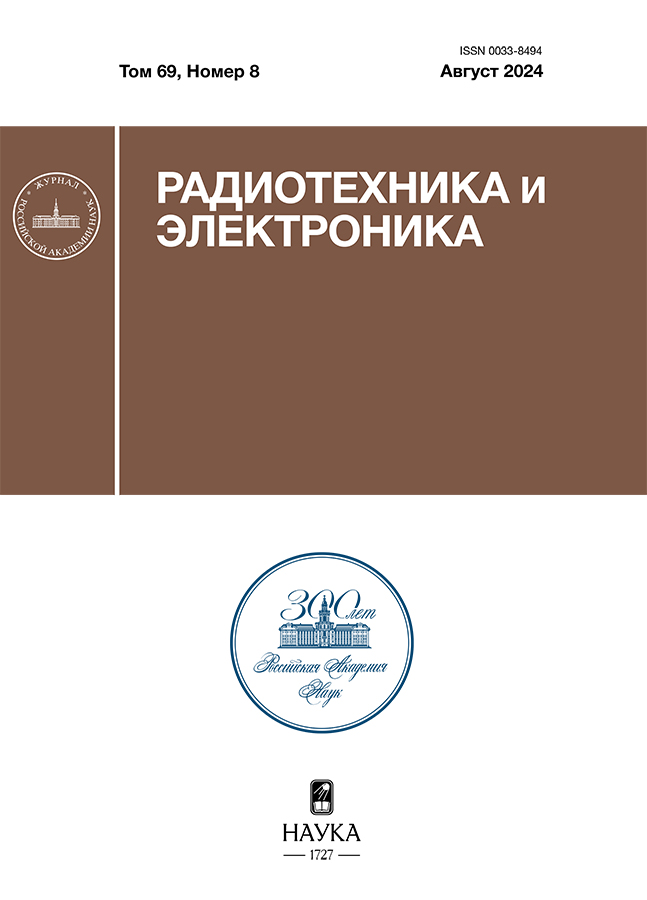Analysis of the phase structure of a signal with linear frequency modulation when processed in high-resolution radars
- Autores: Gavrilov K.Y.1, Mit’kin M.A.2
-
Afiliações:
- Moscow Aviation Institute (National Research University)
- All Russian Radio Research and Development Institute named after M.I. Krivosheev
- Edição: Volume 69, Nº 8 (2024)
- Páginas: 714-726
- Seção: К 90-ЛЕТИЮ М.С. ЯРЛЫКОВА
- URL: https://cijournal.ru/0033-8494/article/view/684803
- DOI: https://doi.org/10.31857/S0033849424080026
- EDN: https://elibrary.ru/HPCSKN
- ID: 684803
Citar
Texto integral
Resumo
The main stages of receiving and processing a linear frequency modulation (LFM) signal reflected from a point moving target are considered. When calculating the phase components of the received LFM signal, the principle of time scale transformation is used, which manifests itself in the mutual movement of the target and the radar station (radar) with pulsed radiation. At all stages of processing the LFM signal, including frequency transfer, quadrature demodulation (selection of the complex envelope of the signal) and matched filtering, the amplitude and phase functions of the signal are determined, allowing coherent processing of a batch of radio pulses. The analysis of the phase structure of the LFM signal is carried out, as a result of which the main phase components are determined, which are taken into account during interperiod signal processing in high-resolution radar.
Texto integral
Sobre autores
K. Gavrilov
Moscow Aviation Institute (National Research University)
Autor responsável pela correspondência
Email: gvrk61@mail.ru
Rússia, Volokolamskoe shosse, 4, Moscow, 125993
M. Mit’kin
All Russian Radio Research and Development Institute named after M.I. Krivosheev
Email: gvrk61@mail.ru
Rússia, Kazakov Str. 16, Build.1, Moscow, 105005
Bibliografia
- Ярлыков М.С. // РЭ. 1971. Т. 16. № 1. С. 92.
- Ярлыков М.С. Применение марковской теории нелинейной фильтрации в радиотехнике. М.: Сов. радио, 1980.
- Ширман Я.Д. Разрешение и сжатие сигналов. М.: Сов. радио, 1974.
- Кук Ч., Бернфельд М. Радиолокационные сигналы / Пер. с англ. под ред. В.С. Кельзона. М.: Сов. радио, 1971.
- Richards M.A. Fundamentals of Radar Signal Processing. New York: McGraw Hill, 2013.
- Principles of Modern Radar. Basic Principles/Eds. by M. A. Richards, J. A. Scheer, W.A. Holm. Raleigh: SciTech Publishing Inc., 2010.
- Yang R., Li H., Li Sh. et.al. High-Resolution Microwave Imaging. Beijing: National Defense Industry Press and Singapore: Springer Nature Ltd, 2018.
- Mahafza B.R., Atef Z. Elsherbeni A.Z. MATLAB Simulation for Radar Systems Design. Boca Raton: Chapman & Hall/CRC, 2004.
- Chen B., Wu J. Synthetic Impulse and Aperture Radar (SIAR). Novel Multi-Frequency MIMO Radar. Beijing: National Defense Industry Press and Singapore: John Wiley & Sons, 2014.
- Gini F., De Maio A., Patton L. Waveform Design and Diversity for Advanced Radar Systems. L.: Institution of Engineering and Technology, 2012.
- Levanon N., Mozeson E. Radar Signals. Hoboken John Wiley & Sons, 2004.
- Ширман Я.Д., Голиков В.Н., Бусыгин И.Н. и др. Теоретические основы радиолокации. М.: Сов. радио, 1970.
- Финкельштейн М.И. Основы радиолокации. М.: Радио и связь, 1983.
- Кондратенков Г.С., Фролов А.Ю. Радиовидение. Радиолокационные системы дистанционного зондирования Земли. Учеб. пособие для вузов / Под ред. Г.С. Кондратенкова. М.: Радиотехника, 2005.
- Cumming I. G., Wong F. H. Digital Processing of Synthetic Aperture Radar Data: Algorithms and Implementation. Boston: Artech House, 2005.
- Гаврилов К.Ю., Каменский И.В., Кирдяшкин В.В., Линников О.Н. Моделирование и обработка радиолокационных сигналов в Matlab (Учеб. пособие). М.: Радиотехника, 2020.
Arquivos suplementares














